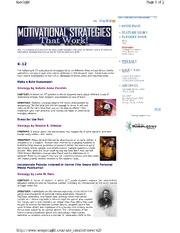Table Of ContentSpotlight Page 1 of 2
enter e-mail address to receive newsletter
Mike
HOME PAGE
FEATURE STORY
IN EVERY ISSUE
News
Tips
Strategies
This is a collaborative column by K-16 library media specialists and academic librarians who write about the College Connection
motivational strategies that have worked for them in teaching IL skills. AASL Resources
ACRL Focus
SPECIALS
K-12 Guest Writer
ABOUT ESD
The following K-12 motivational strategies focus on different ideas school library media
Mission
specialists can use to gain and sustain attention in the research topic. Some have come
from recent submissions to the S.O.S. database of lesson plans and teaching ideas. Credits & Contacts
Issue Summary
Submission Guidelines
Make a Bold Statement!
ARCHIVES
Strategy by Natalie Anne Panshin Fall 2008/Winter 2009
Winter 2008
CONTEXT: A lesson for 5th graders in which students learn about different kinds of
Fall 2007
alternative energy, then research and present on one of them . . . Spring/Summer 2007
Winter 2007
STRATEGY: Teacher-Librarian begins the lesson dramatically by Earlier Issues of ESD
announcing “By the time you are old enough to drive, it will cost
more to fill the car’s tank than you will be able to afford.” This
statement gets their attention and makes the need for alternative
energies relevant.
Funding support from
Dress for the Part
Strategy by Brooke B. Dittmar
CONTEXT: A lesson about the Adirondacks, the rugged life of early settlers, and well-
known early settlers and towns.
STRATEGY: Pique student interest by dressing up as an early settler, a
woodsman or a trapper. Sustain their interest by engaging students in
brainstorming unusual questions to research within the topics of early
Adirondack towns, people, and employments. Sample questions might
include: Why were the “silos” built during the Cold War? How did the
1930 Winter Olympics change Lake Placid and the Adirondacks in
general? Thinking of aspects that are not commonly known and discussed
will create greater student interest in the research topic.
Incorporate Popular Interest in Horror Film Genre With Personal
Media Publication
Strategy by Julie M. Matz
CONTEXT: A series of lessons in which 11th grade students explore the relationships
between literature and its historical context including an introduction to the short stories
of Edgar Allan Poe . . .
STRATEGY: Capitalizing on the intense popularity of the horror film
genre and emergence of personal media publication (Myspace,
YouTube, podcasts), this lesson plan strategy takes high school
Juniors on a virtual trip back in time to read the author who created
the literary genre that started it all: Edgar Allan Poe. While Poe used
his pen to publish his tortured human nature, students take a Poe
work of their choice and reproduce it in a twenty-first century media
format best suited for its special effects. The combination of the
horror/mystery/madness genre with technology helps sustain
attention as students practice a number of information skills in the
http://www.sosspotlight.com/site_creator/view/420
Spotlight Page 2 of 2
context of the curricular content. To get this lesson rolling on Day 1,
students entered the classroom to the sounds of eerie organ music, a successful
attention-grabbing strategy.
Images for K-12 motivational strategies purchased from istockphoto.com
College Level
Student-Directed Database Searching Activity
Reported by Lorna Rodio, Reference Librarian,
Massasoit Community College Library, MA
Rather than doing a search demo, we divide the class into small groups and give each
group a database searching activity. We ask a few questions about the search results on
the handout and also remind students that we will be asking them about the searches.
Usually each group will have members with different levels of abilities, so this has worked
really well. Someone in the group will usually emerge as the searching leader, and
someone else will seem to be the natural spokesperson for the group. The really
interesting part to the students is when we talk about the results. The students will
usually share what didn’t work as well as what did and each group will probably be talking
about a different database. I usually do the search as they talk about it at the teachers’
station, so everyone in the class gets to see each search, but the demo is directed by the
students. The questions I put on the handout are usually designed to illustrate the things
I want them to consider: source publication, date, etc.
This teaching idea and corresponding handouts are available in the S.O.S. database:
http://informationliteracy.org/ideas/view/956/back/0
Please share your "motivational strategies that work" with your colleagues by
sending them to the editor at [email protected]
http://www.sosspotlight.com/site_creator/view/420

